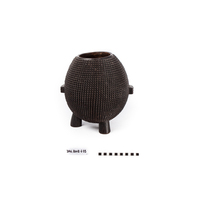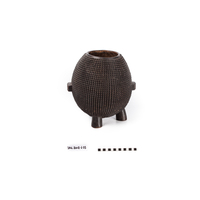Metadata
Vessel
[ Source of title : Chloe Rushovich using JAG materials ]
Object
2012-6-33
Creative Commons License: CC BY-NC-ND https://creativecommons.org/licenses/by-nc-nd/4.0/
Description [Source - Phillipa van Straaten, curator of the Traditional Collections at JAG, for FHYA using JAG materials, 2017: Vessel, Northern Nguni, 19th century; Description: Carved wooden vessel, with amasumpa patterens across surface, three dumpy legs and small lugs; Dimensions: 32,5cm x 30,7cm x 27,3cm Material: Wood, carving.]
Acquisition [Source - Phillipa van Straaten, curator of the Traditional Collections at JAG, for FHYA using JAG materials, 2017: Acquired from: Maritz acquired this item from Jonathan Lowen, it was then purchased by the Anglo American Johannesburg Centenary Trust (AAJCT) from Maritz, and then donated to JAG by the AAJCT.]
Attributions and conjectures [Source - Nessa Leibhammer for FHYA, 2017: Comments on classification: In his 'A Preliminary Survey of the Bantu Tribes of South Africa', Union of South Africa, Department of Native Affairs, Ethnological Publications, Vol. 5, Pretoria, Government Printer, (1935): 7, 70-83, national government ethnologist, Nicholas Van Warmelo did not use the term "North Nguni". He grouped people living both north and south of the Thukela, under one umbrella term, "Natal Nguni", based on linguistic affinity. His classification was adapted by the ethnology curator, Margaret Shaw, in her 1958 "System of Cataloguing Ethnographic Material in Museums" which determined that items from the region were to be classified as "Natal Nguni: Zulu and others (not differentiated)." According to art historian, Anitra Nettleton, the classificatory system used by art galleries and museum shifted from Shaw's model to the one where "Natal Nguni" fell away and was replaced by "North/Northern Nguni" for KwaZulu-Natal and Swaziland because scholars found it difficult to distinguish items from adjacent areas, or emigrant people from those from the KZN region. Scholars working with the JAG materials used broad ethno-linguistic categories (Zulu, Xhosa, Tsonga, Shona, Sotho, Tswana) to identify the makers/users of the objects, all of which came to JAG without much by way of provenance, and identification was based on factors such as object type, materials, formal composition, style and surface patterning (emails A. Nettleton to N. Leibhammer, 25 and 28 November 2014).]
| Event Actor | Event Type | Event Date | Event Description |
|---|---|---|---|
| Five Hundred Year Archive (FHYA) | Online curation | 2016 - | Digital image by Nessa Leibhammer |
| Johannesburg Art Gallery (JAG) | Custody | 2012 - | |
| Nicholas Maritz | Collection | [19-?] | |
| Unacknowledged | Making | YYYY |
If you have difficulty accessing the objects, use these links.



Contributions